 |
 |
 |
HOME > FOCUS > All Porcelain, All the Time: The Toguri Museum of Art |
 |
 |
Focus features two in-depth reviews each month of fine art, architecture and design exhibitions and events at art museums, galleries and alternative spaces around Japan. The contributors are non-Japanese art critics living in Japan. |
|
|
 |
 |
 |
All Porcelain, All the Time: The Toguri Museum of Art
Alice Gordenker |
 |
|
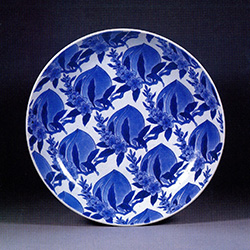 |
|
|
|
Dish with repeated peach motif and blossom and foliage design in blue underglaze. Nabeshima ware. Edo period, late 17th to early 18th century.
|
You wouldn't find it unless you were looking for it, but nestled away among embassies in an upscale neighborhood of Tokyo is a museum housing one of the world's best collections of old Japanese porcelain. Just a 15-minute walk from the bustle of Shibuya Station, the Toguri Museum of Art nevertheless feels a world apart, with quiet galleries and a small but lovely traditional garden.
Businessman Toru Toguri (1926-2007) started collecting Japanese antiques in the 1960s in response to what he saw as an overwhelming influx of Western culture into postwar Japan. Concerned that the country's indigenous culture would be irrevocably lost, he sought to preserve for future generations what their ancestors had achieved. In the process, he developed a particular interest in old porcelain. By 1987, he had amassed so many fine pieces that he decided to open a museum. The Toguri Museum of Art focuses on Edo-era Japanese porcelain; its collection now amounts to nearly 7,000 pieces of which about 100 are on display at any one time.
 |
|
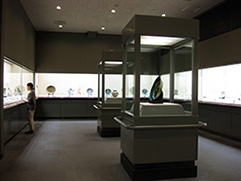 |
|
|
|
The Toguri Museum of Art |
|
View of the second-floor exhibition space |
There are other museums around the world with strong collections of Japanese porcelain, including the British Museum in London, the Guimet Museum in Paris, and the Idemitsu Museum in Tokyo, to name just a few. But these are general museums and may not always have much Japanese porcelain on display. There are also institutions that, like the Toguri, keep a large number of pieces on permanent display, including the Dresden State Art Collections in Germany and the Kyushu Ceramic Museum in Arita, Saga Prefecture, but these aren't the easiest places to get to. In terms of seeing a good number of top-quality works in one go at a convenient location, you can't do much better than the Toguri.
On the second floor, in the room to the far right at the top of the stairs, is a permanent exhibit of about 25 works that provides a nice overview of Japanese porcelain made during the Edo period (1603-1868). The rest of the exhibition space is given over to special shows that change every three months. As the museum does not lend or borrow, all the pieces you'll see can't be seen anywhere else.
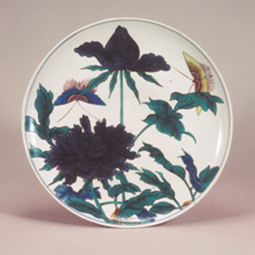 |
|
 |
|
|
|
| Left: Dish with peony and butterflies. Right: Dish with uri melon and snowflake pattern. Both are Imari ware in the Ko-kutani style. Edo period, mid-17th century. |
Given the quality of the collection there will always be plenty to satisfy informed connoisseurs, but curators also emphasize education in the hope that even someone who knows nothing at all about porcelain will come away with new knowledge and appreciation.
Porcelain is a type of ceramic made with special clay and fired at very hot temperatures. Japan was a latecomer to porcelain manufacturing, compared to China and Korea, because it initially lacked the right clay and necessary know-how. But in the 1610s, using technology introduced from Korea, porcelain manufacturing started in and around Arita, which was under the control of the Nabeshima feudal clan. In the middle of the century, political unrest in China disrupted that country's trade and the Dutch East India Company, which had been buying huge quantities of Chinese porcelain for resale in Europe, turned to Japan as an alternate supplier. Products were shipped from the nearby port of Imari, which is why porcelain from this part of Japan came to be known as Imari ware.
In the 1920s, scholars working on Edo-era porcelain made by the Nabeshima clan identified three distinct styles as being particularly attractive. These styles, which came to be known as Ko-kutani, Kakiemon, and Nabeshima, remain very popular with enthusiasts today and the current exhibition brings them together to good effect.
|
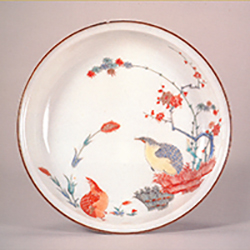 |
|
|
|
Dish with quails under arching bamboo with plum tree and millet. Imari ware in the Kakiemon style. Edo period, second half of 17th century.
|
The Ko-kutani style, which was produced from around the 1640s and traded almost exclusively in the domestic market, is famous for bold, dynamic designs and distinctive enamel colors including blue, purple, yellow, green, red, and black. In some cases, the designs on Ko-kutani ware were executed to cover the entire surface, perhaps to hide less than ideal color in the porcelain base. In contrast, the Kakiemon style, which emerged around the 1670s and was produced mostly for export, is characterized by asymmetrical patterns sparsely applied to emphasize the pure white background that became possible as techniques improved. Kakiemon pieces were widely copied by porcelain makers in Europe.
|
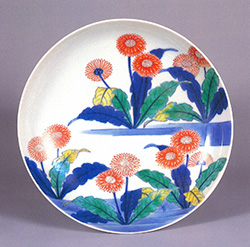 |
|
|
|
Dish with dandelion design. Blue underglaze and overglaze enamels. Nabeshima ware. Edo period, late 17th - early 18th century.
|
Yet another style, called Nabeshima, developed during the second half of the 17th century with a very specific purpose: objects in this style were made exclusively for gift-giving by the Nabeshima clan, to be presented as homage to the Tokugawa shogun and other high-ranking dignitaries. A clear effort was made at the time to distinguish Nabeshima ware from other porcelain, with patterns, shapes, and sizes all strictly regulated. Nabeshima ware is characterized by highly refined designs, often depicting flowers, plants, and other themes from nature; geometric patterns and motifs seen in kimono design were also favored.
Interestingly, the exhibition draws attention to similarities that, along with extensive research in recent years, make it clear that the three styles are more closely related than originally thought. Pieces are grouped to show transitions in style and demonstrate that certain patterns and techniques were shared. One fascinating example is a pair of gourd-shaped bottles that are decorated in typical Ko-kutani style below, with blue, green, and black enamels, while their upper halves show the dominant use of red associated with the Kakiemon style.
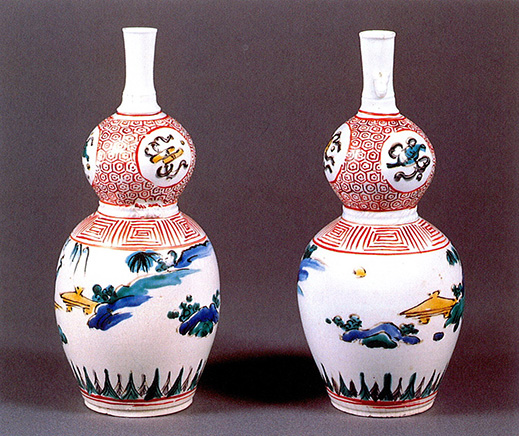 |
|
| Gourd-shaped bottles with landscape designs. Imari ware. Edo period, mid-17th century. |
Now under the direction of the founder's son, Osamu Toguri, the museum is making an effort to become better known outside of Japan. Captions for all works include basic information in English, and while the explanatory panels in the exhibits are in Japanese only, you can pick up a handout in English at the ticket counter that summarizes the current exhibition and points out a few highlights. The museum recently started guided tours in English, which are free with museum admission. The next scheduled tours are November 22 and December 13. For details, please see the museum's website.
Left: Imari-ware dish with arabesque design. Edo period, late 17th to early 18th century. Right: Nabeshima-ware dish with similar arabesque pattern featuring chrysanthemums. Edo period, mid-17th century.
All images courtesy of the Toguri Museum of Art. |
|
|
|
 |
Exhibition of Ko-kutani, Kakiemon and Nabeshima Ware |
 |
Toguri Museum of Art |
 |
4 October - 23 December 2014 |
|
|
 |
 |
Alice Gordenker
Alice Gordenker is a writer and translator based in Tokyo, where she has lived for more than 16 years. In addition to writing about the Japanese art scene she pens the "So, What the Heck Is That?" column for The Japan Times, which provides in-depth reports on everything from industrial safety to traditional talismans. She also writes about early Japanese photography. |
|
 |
|
|
 |
|
 |
|